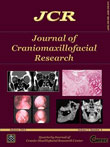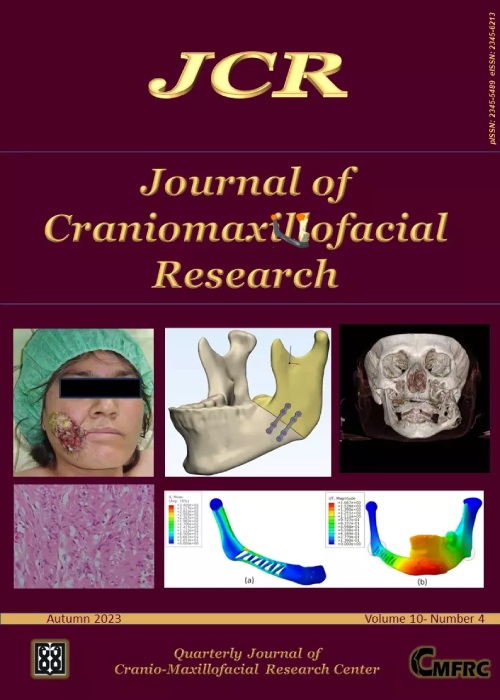فهرست مطالب

Journal of Craniomaxillofacial Research
Volume:2 Issue: 1, Winter-Spring 2015
- تاریخ انتشار: 1394/02/25
- تعداد عناوین: 9
-
-
Page 69Craniofacial anomalies include clefts, synostoses, atrophic abnormalities, neoplasias etc. among which cleft lip and/or palate caused by abnormal facial development during gestation is one of the most prevalent congenital defects. Its overall occurrence is about 1:700 ranging from 0.02 to 4.04 in 1000 live births. There are different etiologic factors considering the cleft cause. In most cases the exact cause is unknown, but it is thought to be a combination of genetic (internal) and environmental (external) factors. A cleft lip and palate can have a profound psychological impact both on the parents and the child. It affects the appearance of the face, also lead to problems with feeding, speech and language and hearing due to ear infections. Speech and aesthetic concerns seem to have been important factors affecting the health-related quality of life for children with oral clefts. It is obvious that cleft lip and palate can have a substantial impact on the health economics of countries in the developing world. The multispecialty approach to the care of children with clefts is highly recommended. A research registry can be of invaluable assistance to physicians and researchers by providing an available panel of patient information that could assist in understanding the patients they are serving, utilization of health care services, and the design and implementation of research studies to improve patient care. The Cleft Lip/Palate and Craniofacial Anomalies Registry may be functioning with a mission to promote better understanding of cleft lip/palate and craniofacial anomalies and to improve patient care and health care planning. Data collection can provide better resources for future interventional studies. As it helps to have an accurate picture of the childrens number in need of treatment in a population. Recording the data of cleft patients and treatment teams and their workload is necessary for planning about providing training centers for members of treatment teams.Keywords: Craniofacial anomalies, Cleft, Registry, Healthcare
-
Page 74IntroductionBisphosphonates are widely used for various bone diseases including osteoporosis and bone tumors. One of the complications associated with these pharmaceutical agents is bisphosphonate-related osteonecrosis of the jaw. This condition may be triggered by placement of dental implants. In turn, osteonecrosis of the jaw may cause failure in osseointegration of implants. Moreover, bisphosphonates can influence osseointegration of dental implants by alteration of bone turnover. The aim of this study was to review the published articles on osseointegration of dental implants in patients taking oral bisphosphonates.
Material andMethodsPubMed/Medline database was searched for published articles until 31 January 2014 using osseointegration and bisphosphonate as keywords. Inclusion criteria were human studies including case series, retrospective studies and prospective studies on the subject. Exclusion criteria were case reports, intravenous bisphosphonate intake, and placement of implants in other parts of the body rather than jaws.ResultsA total of 66 articles were evaluated at abstract level. Eventually 4 articles were chosen including nearly 1470 patients taking oral bisphosphonates. Failure in osseointegration of dental implants or its loss was observed in 23 patients. This shows failure in integration between bone and implant in approximately 1 out of 64 patients taking oral bisphosphonates. Accordingly impaired osseointegration was observed in 1.44% of patients with bisphosphonate intake.ConclusionAlthough failure in osseointegration of dental implants in patients with bisphosphonate intake is unlikely, the risk of failure should be considered in treatment planning for these patients and utmost care should be employed to prevent possible complications.Keywords: Bisphosphonate, Osseointegration, Dental implant -
Page 78IntroductionWe studied and measured facial parameters of 160 students, aged 22-24 years attended at Sahand University of Technology in Northwest of Iran.
Material andMethodsIn this paper, six linear and six angular facial parameters are measured. These parameters are measured in frontal and profile facial images. The measured values are the mean and standard deviation (SD) of distance between the two medial canthi, width of alar base, length of nose, width of mouth, length of upper lip, length of lower lip, interlabial gap, nasofrontal angle, nasofacial angle, nasomental angle, nasolabial angle, mentolabial angle, and throat angle. The mean (SD) of the above mentioned parameters were 33mm (3), 38mm (2), 49mm (2), 46mm (3), 16mm (3), 14mm (1), 4mm (0.75), 127 (3), 31 (2), 127 (3), 112 (5), 135 (3), 12 (2), respectively.ResultsMost of the parameters we measured were comparable in men and women. When we compared our results with studies in South of Iran and elsewhere many differences were found and this shows that the measurement of the facial parameters in different races, ethnic groups, and regions of country is necessary.ConclusionMeasurement of these parameters is vital in facial surgeries especially in aesthetic, maxillofacial, rhinoplasty and orthognathic surgeries.Keywords: Frontal image, Profile image, Facial soft tissue analysis, Horizontal measurement, Transverse measurement -
Page 83IntroductionOur study was designed to assess the effect of the submucosal injection of dexamethasone on postoperative discomfort after surgical removal of impacted mandibular third molars.Materials And MethodsTwenty six patients with bilaterally bony impacted mandibular third molars were recruited to this split mouth study. On the study side, prior to surgery, 8 mg of dexamethasone was injected in buccal vestibule submucosally, while the control side received no steroid. Complications such as swelling, trismus and infection were evaluated postoperatively.ResultsThe results showed that the patients experienced significantly less swelling (p= 0.001) on study side on the 3rd and 7th postoperative days compared to the control side. The amount of trismus was significantly less (p= 0.001) after submucosal injection of dexamethasone on both time intervals.ConclusionPerioperative submucosal injection of dexamethasone can significantly reduce postoperative swelling and trismus after surgical removal of the impacted teeth.Keywords: Third molar, Swelling, Trismus, Dexamethasone
-
Page 86IntroductionDue to the increase in Le Fort surgeries and its effect on nose widening, it seems necessary to use an alternative method without this effect. The present research examined the effect of alar release on interalar changes in Le Fort I osteotomy.Materials And MethodsThe study population included patients admitted to Bou-Ali Hospital in 2012-2013 undergoing Le Fort I osteotomy. The samples were 26, selected using simple random sampling method. Fourteen patients who underwent osteotomy with alar release were considered as experimental group and 12 who underwent conventional orthognathic surgery considered as control group. Then, the width of interalar was measured with actual size in photography.ResultsThe initial interalar width in experimental group was 4.1 mm; 12% wider than control group (pConclusionBasically, using alar release would probably prevent increase of interalar width in Le Fort I osteotomy.Keywords: Alar release, Interalar, Osteotomy, Le Fort I
-
Page 91IntroductionThe trigeminocardiac reflex (TCR) refers to the sudden development of bradycardia as well as asystole along with arterial hypotension associated with any manipulation of sensory branches of the trigeminal nerve. Clinically, the TCR has been reported to occur during craniofacial surgery. It is crucial to learn about this sudden physiological response during maxillofacial surgery that is likely to happen with any craniofacial surgical procedures.Materials And MethodsIn this clinical study 44 volunteers without any systemically compromising conditions were divided into 2 groups. The first group underwent Le Fort I osteotomy and the second mandibular osteotomy. Mean arterial blood pressure and pulse rate (MABP1, PR1) values were recorded before down fracture (DF) of maxilla and Sagittal Splitting (SS) of mandible, during DF and SS (MABP2, PR2), and after DF and SS (MABP3, PR3). The data were analyzed using repeated measure ANOVA tests (p = 0.05).ResultIn Le Fort I group, PR1 and PR3 were significantly higher than PR2 (PConclusionIt is concluded that TCR is triggered by the stimulation of V2 but V3 branch stimulation does not cause such reflex.Keywords: Trigeminocardiac reflex (TCR), Le Fort Osteotomy, Sagittal split ramus osteotomy
-
Page 95IntroductionThe incidence and etiology of maxillofacial fractures vary widely between different countries. Understanding the cause and pattern of these injuries can assist in establishing clinical and research priorities for more effective treatment and prevention of maxillofacial injuries. The study aimed to evaluate the etiology and pattern of maxillofacial fractures in trauma patients hospitalized in Shariati Hospital in Tehran, Iran.Materials And MethodsA prospective analysis of all maxillofacial fracture patients admitted to the Department of Oral and Maxillofacial Surgery was performed during a 12-month period from November 2010 to November 2011. Recorded data included age, sex, cause of trauma, and the pattern of maxillofacial fractures.ResultsA total of 302 consecutive patients were included in the study, with a male to female ratio of 3.4:1. Most patients (41.3%) were in the third decade of life (20-29 year-old). Motor vehicle accidents (MVA) were the most common cause of injury (50%), followed by interpersonal violence (30%). Mandible fracture was the most common fracture (41%), followed by midface fracture (34%). Fracture of the body of the mandible (24%) was the most common mandible fracture; and the most common midface fracture was zygomaticomaxillary fracture (32%).ConclusionsIn most other epidemiologic studies of maxillofacial fractures, MVA was the main cause of injury; and mandible the most common site of fracture. However, the vagueness and imprecision in the classification and nomenclature of maxillofacial fractures has led to confusing results that are difficult to compare.Keywords: Maxillofacial Trauma, Epidemiology, Fracture
-
Page 103A palatal defect may result from surgical resection, and its consequences could include difficulty in speech and nasal regurgitation of food and liquids. An obturator combined to speech aid prosthesis can improve nasal emission during speech, and assist in preventing nasal regurgitation of food. This article presents a clinical report of the reconstruction of palatopharyngeal function by prosthetic obturator and speech aid.Keywords: Palatopharyngeal function, Speech Aid, Obturator, Rotational path
-
Page 109The infratemporal fossa is an anatomic space of great importance in the head. Abscesses of this space are rare but potentially life threatening. Regarding the proximity of some important anatomical features of the head, dealing with infratemporal space infection needs great consideration both in examination and surgical practice. In this case report, infratemporal space abscess formation following the removal of zygomatic arch suspension wire in a healthy, male, young patient and its treatment protocol are presented.Keywords: Infratemporal, Abscess, Maxillofacial infection Introduction


